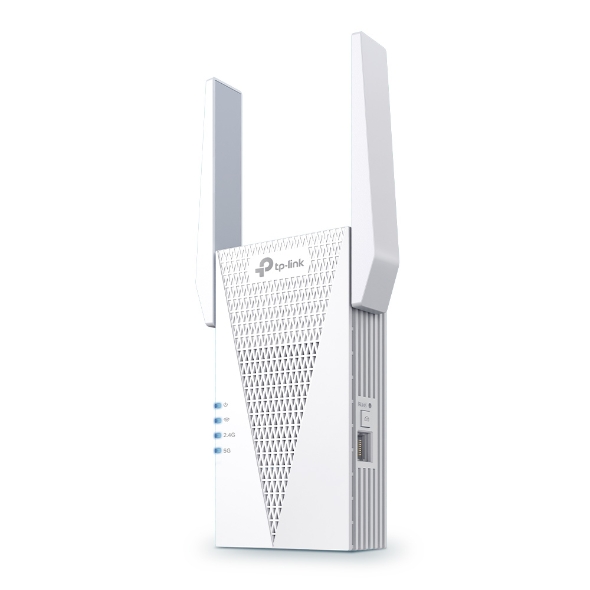(Part – RE715X) AX3000 Mesh WiFi 6 Extender – Range Extenders – Networking – TP-Link
AX3000 Mesh WiFi 6 Extender
- Dual Band WiFi 6 – Separates 5 GHz (2402 Mbps) and 2.4 GHz (574 Mbps) WiFi bands for faster speeds and greater capacity with the latest technology
- Uninterrupted Streaming – Easily create a TP-Link OneMesh™ network for seamless whole home WiFi coverage
- AP Mode – Create a new WiFi access point through the Gigabit Ethernet port to enhance your wired network with WiFi capability
- Gigabit Ethernet Port – Provides high-speed wired access, ideal for smart TVs, PCs, and game consoles
- App Control – Easy Setup and management with your network using the TP-Link Tether app
Call for Price
| Working Modes | Range Extender / Access Point |
|---|---|
| Ports | 1 Gigabit Ethernet Port |
|---|---|
| Button | WPS Button, Reset Button |
| Input Power | 100-240V~50/60Hz |
| Power Consumption | 15.2W |
| Dimensions ( W x D x H ) | 107*40*160 |
| Antenna | 2 External Antennas |
| Wireless Standards | IEEE 802.11a/n/ac/ax 5GHz, IEEE 802.11b/g/n/ax 2.4GHz |
|---|---|
| Frequency | 2.4GHz and 5GHz |
| Signal Rate | 574 Mbps at 2.4GHz, 2402 Mbps at 5GHz |
| Working Modes | Range Extender / Access Point |
| Reception Sensitivity | 5GHz: 11a 6Mbps:-97dBm 11a 54Mbps:-78dBm 11ax HE20 MCS0: -97dBm 11ax HE20 MCS11: -66dBm 11ax HE40 MCS0: -94dBm 11ax HE40 MCS11: -62dBm 11ax HE80 MCS0: -92dBm 11ax HE80 MCS11: -61.5dBm 11ax HE160 MCS11: -59dBm 2.4GHz: |
| Transmit Power | 2.4GHz ≤16dBm, 5GHz ≤21dBm |
| Wireless Modes | Range Extender / Access Point |
| Wireless Functions | Enable/Disable Wireless Radio, Wireless Statistics |
| Wireless Security | WEP, WPA, WPA2, WPA3 |
| Transmission Power | 2.4GHz ≤16dBm, 5GHz ≤21dBm |
| Mesh Technology | EasyMesh-Compatible |
| Certification | RoHS |
|---|---|
| Package Contents | Wi-Fi Range Extender RE715X Quick Installation Guide |
| System Requirements | Microsoft Windows 98SE, NT, 2000, XP, Vista™ or Windows 7, 8, 8.1, 10, MAC OS, NetWare, UNIX or Linux Internet Explorer 11, Firefox 12.0, Chrome 20.0, Safari 4.0, or other Java-enabled browser |
| Environment | Operating Temperature: 0℃~40℃ (32℉ ~104℉) Storage Temperature: -40℃~70℃ (-40℉ ~158℉) Operating Humidity: 10%~90% non-condensing Storage Humidity: 5%~90% non-condensing |
1.The product may not be compatible with routers or gateways with firmware that has been altered, is based on open source programs, or is non-standard or outdated.
2.Use of MU-MIMO requires clients to also support MU-MIMO.
3.Need to be used in 5G frequency band with equipment supporting 160MHz
4.Requires compatible AX clients with DL-OFDMA and UL-OFDMA support.
5.Maximum option is enabled by default.
Actual network speed may be limited by the rate of the product’s Ethernet WAN or LAN port, the rate supported by the network cable, Internet service provider factors and other environmental conditions.







